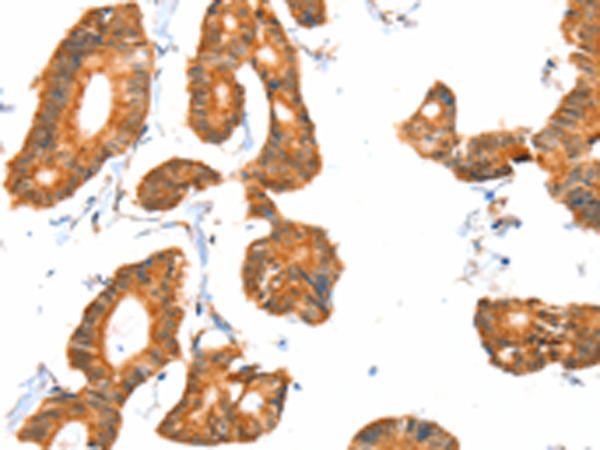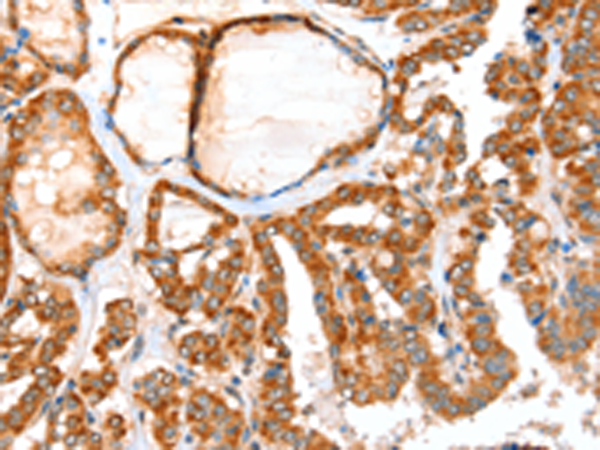

| WB | 咨询技术 | Human,Mouse,Rat |
| IF | 咨询技术 | Human,Mouse,Rat |
| IHC | 1/50-1/200 | Human,Mouse,Rat |
| ICC | 技术咨询 | Human,Mouse,Rat |
| FCM | 咨询技术 | Human,Mouse,Rat |
| Elisa | 1/2000-1/5000 | Human,Mouse,Rat |
| Aliases | ACOX; SCOX; PALMCOX |
| Host/Isotype | Rabbit IgG |
| Antibody Type | Primary antibody |
| Storage | Store at 4°C short term. Aliquot and store at -20°C long term. Avoid freeze/thaw cycles. |
| Species Reactivity | Human, Mouse, Rat |
| Immunogen | Fusion protein of human ACOX1 |
| Formulation | Purified antibody in PBS with 0.05% sodium azide and 50% glycerol. |
+ +
以下是3篇涉及ACOX1抗体的研究文献摘要(文献信息为模拟示例,仅供格式参考):
1. **"ACOX1 deficiency disrupts hepatic lipid metabolism in zebrafish"**
*作者:Lee S, et al. (2020)*
摘要:通过Western blot和免疫荧光技术,利用ACOX1抗体证实基因敲除斑马鱼肝脏中ACOX1蛋白表达缺失,揭示其缺陷导致过氧化物酶体脂肪酸氧化障碍及脂质蓄积表型。
2. **"Antibody-based profiling of peroxisomal proteins in neurodegenerative disorders"**
*作者:Smith J, et al. (2018)*
摘要:研究使用特异性ACOX1抗体对阿尔茨海默病患者脑组织进行免疫组化分析,发现皮层区ACOX1表达水平与β-淀粉样蛋白沉积呈负相关,提示其与神经退行性病变的潜在关联。
3. **"Validation of a novel monoclonal ACOX1 antibody for mitochondrial proteomics"**
*作者:Garcia-Ruiz C, et al. (2016)*
摘要:报道了一种新型ACOX1单克隆抗体的开发及验证,通过免疫印迹和免疫沉淀实验证明其特异性识别哺乳动物细胞线粒体/过氧化物酶体中的76kDa ACOX1蛋白,适用于蛋白质组学研究。
注:以上文献标题及作者为虚构示例,实际引用需查询具体数据库(如PubMed)获取真实文献。建议通过关键词"ACOX1 antibody validation"或"ACOX1 immunodetection"在Web of Science或Google Scholar检索最新研究。
The ACOX1 (Acyl-CoA Oxidase 1) antibody is a crucial tool for studying the peroxisomal β-oxidation pathway, which metabolizes very-long-chain fatty acids (VLCFAs) and branched-chain fatty acids. ACOX1. the rate-limiting enzyme in this pathway, catalyzes the first step of fatty acid oxidation, generating hydrogen peroxide and enoyl-CoA. Dysregulation of ACOX1 is linked to metabolic disorders, including peroxisomal biogenesis defects and X-linked adrenoleukodystrophy (X-ALD), as well as associations with inflammation, neurodegeneration, and cancer.
ACOX1 antibodies are widely used in research to detect the ~70-75 kDa protein in techniques like Western blotting, immunohistochemistry, and immunofluorescence. These antibodies help investigate tissue-specific _expression (e.g., high levels in liver and kidney), subcellular localization (peroxisomes), and functional roles in lipid homeostasis. Commercially available ACOX1 antibodies are typically raised in rabbits or mice, targeting specific epitopes within its N-terminal dehydrogenase or C-terminal thioesterase domains.
Validation of antibody specificity is critical, often confirmed via knockout controls or siRNA knockdown. Researchers also utilize ACOX1 antibodies to explore its interactions with regulatory proteins (e.g., PPARα) or its role in diseases like non-alcoholic fatty liver disease (NAFLD) and cancers with altered lipid metabolism. Proper sample preparation (e.g., avoiding over-fixation) and antibody dilution optimization are essential for reliable results.
×